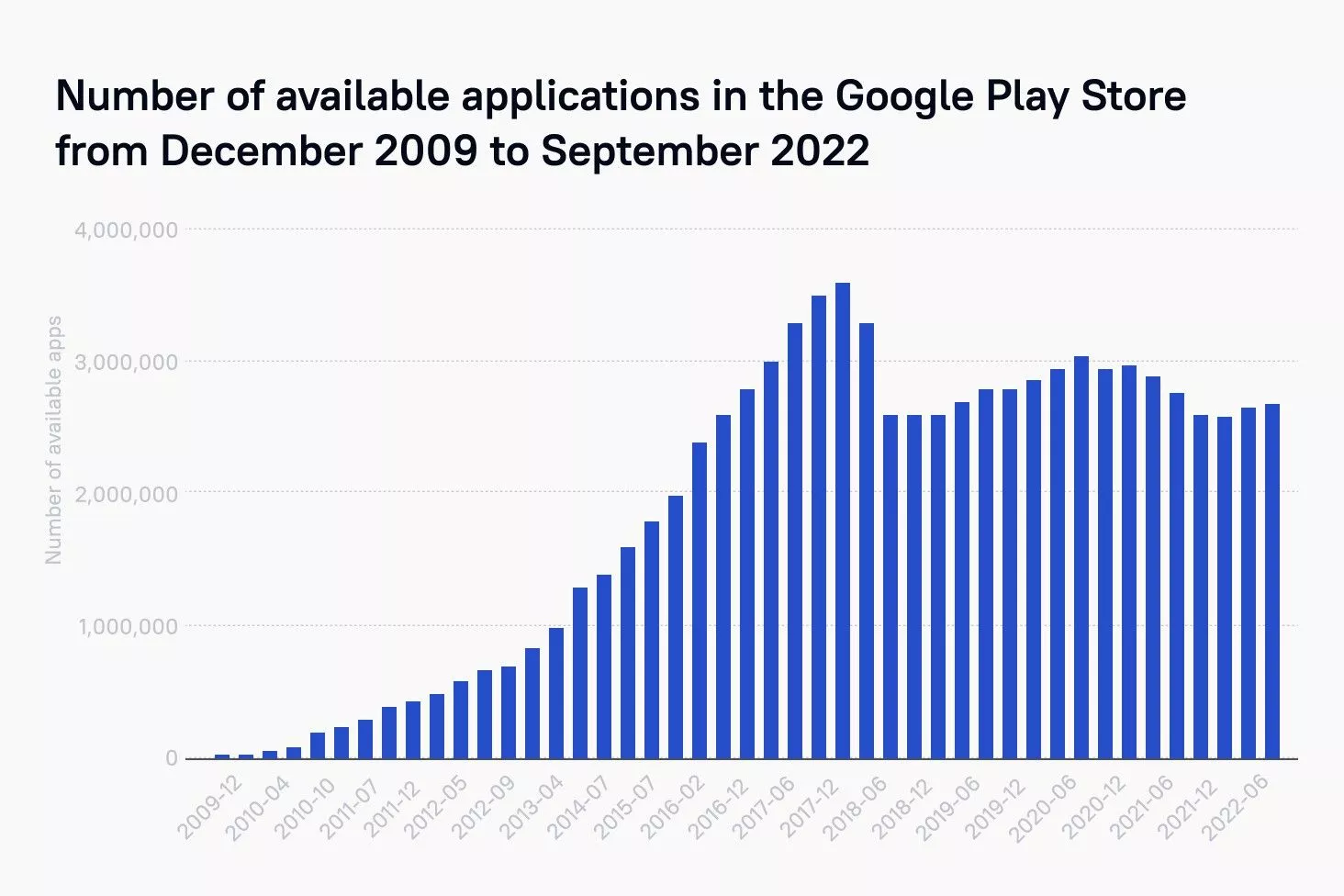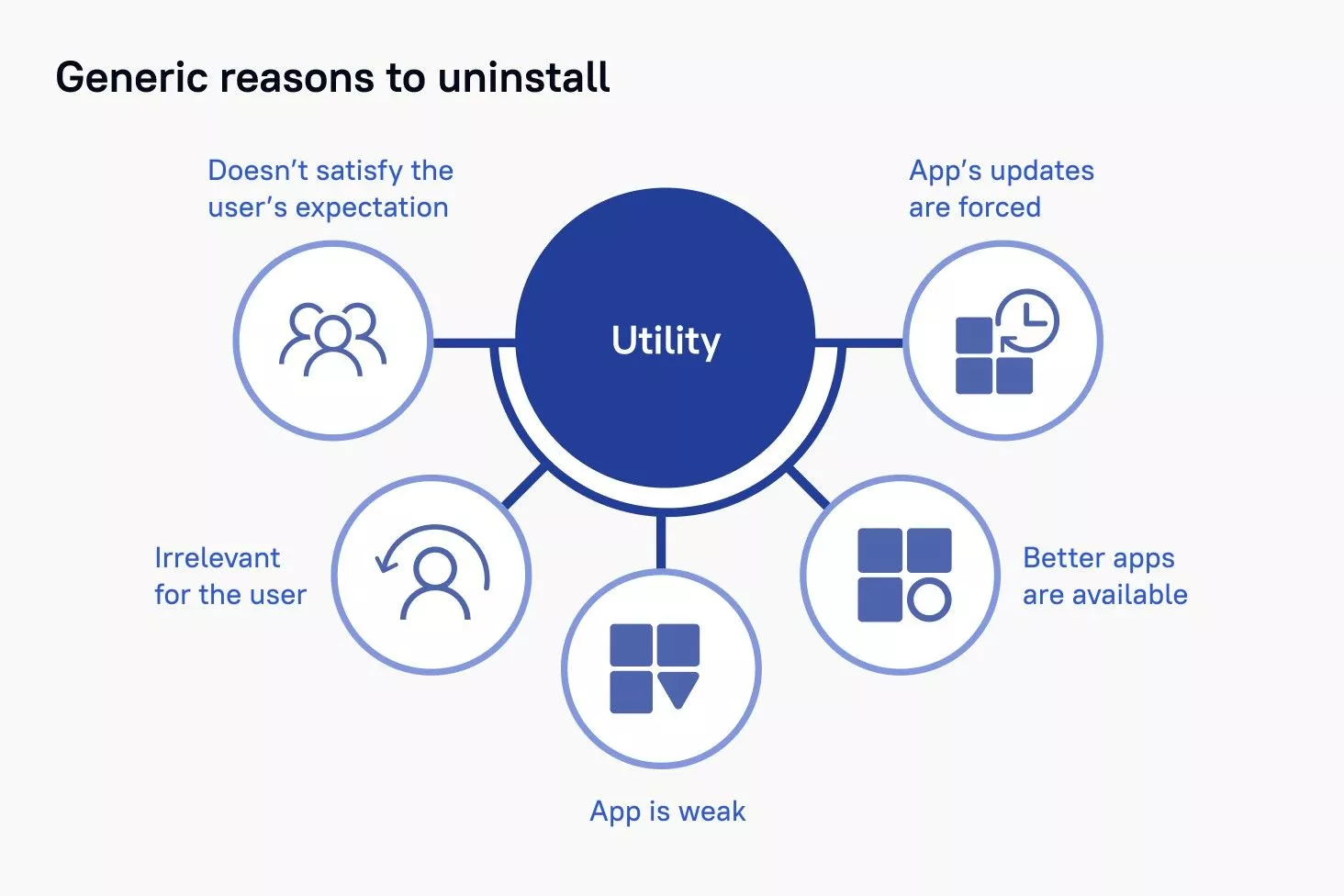
Immortality does not exist even in today's high-tech world. Any software will fall into disrepair without proper maintenance. Mobile applications are the most vulnerable due to the rapid rate of development in this market and ever-increasing user expectations. In this blog post, we will go through what mobile app maintenance support is, what app maintenance costs are and why it is needed.
The Background of App Maintenance Cost
It has been a phenomenal few years for the mobile applications market. Both the Google Play Store and Apple App Store offer more than 4 million solutions. The Google Play Store is forecast to have 143 billion mobile apps downloaded143 billion mobile apps downloaded by 2026. Compared with 2021, it is almost 30 percent more than the 111 billion applications downloaded then.
This growth in the market has led to an increased focus on the development process. This process involves several stages, including:
- discovery and planning;
- Design stage;
- development;
- Testing and QA;
- deployment.
However, once an application is launched, it enters the maintenance phase. It takes constant work to maintain it. Let's find out not only how much does it cost to maintain an application, but why it’s worth it. Maintenance guarantees that the app will always be up-to-date, safe, and functional. It involves monitoring, bug fixes, and content updates. All enhancements are to meet user expectations and adapt to changing requirements.
Regular maintenance allows for spreading the costs of bug fixing over a longer period. This maximizes the return on investment. The most important thing is that it ensures a good user experience. It is estimated that 53% of app users will abandon the software if it freezes, crashes, or takes too long to load. Maintenance helps to optimize performance, streamline user interfaces, and enhance user satisfaction.
Want a web app that does more?
Let's build a solution that's smart, sleek, and powerful.
Alina
Client Manager

7 Reasons to Maintain an App
Here are some key reasons why application maintenance is essential.
Bug Fixes
Maintaining your system regularly will help you identify flaws, glitches, and performance issues. This ensures a smooth and error-free user experience.
Security Updates
The techniques used by hackers and cybercriminals also evolve with technology. Service maintenance includes applying security updates and the necessary patches to protect against potential vulnerabilities. This promotes user trust, protects user data, and stops illegal access.
Compatibility with Operating System Updates
Operating system updates (for iOS or Android) release new features, improvements, and changes. By maintaining an app, you can keep it compatible with the latest versions of operating systems. This compatibility is crucial for delivering a seamless UX. In the end, your program functions correctly on updated devices.
Performance Optimization
Over time, the software’s performance can degrade. The reasons for this include increased data usage, changes in user behavior, or updates to the underlying technology. Regular maintenance allows for performance optimization. It involves identifying and addressing bottlenecks. It is also about optimizing code and improving program speed and responsiveness.
Feature Enhancements and Updates
Users' feedback and market trends can help you add new features, functionality, and improvements. Thus, your business can stay competitive, attract new users, and retain existing ones. Regular updates also prove your commitment to providing a valuable and evolving experience.
Server and Database Management
Many programs rely on servers and databases to store and process user data. Regular maintenance includes monitoring server performance and optimizing database queries. You also need to ensure scalability to accommodate growing user bases. Effective server and database management contribute to app stability and user satisfaction. With it, you can efficiently handle data.
User Support and Engagement
Maintenance involves addressing user inquiries, feedback, and support requests promptly. By providing excellent customer support, you can build a positive reputation. It helps retain loyal users. Tools like Google Analytics can provide valuable and helpful insights. However, they may come with additional costs. Engaging with users also allows you to gather beneficial insights. Thus, you can identify areas for improvement in future updates.
Push notifications are an effective way to inform users about new content or updates. Yet, they need ongoing maintenance to ensure they are delivered accurately.
Why is it Important to Update Your App?
A new mobile product for Android or iOS is ready! The app is published and people start downloading it. After the first wave of downloads has passed, user activity decreases. If you do not release an update, the application may be lost in a sea of other programs.
Refreshing mobile apps are essential to retain users and keep the feeling that your business is still there and doing well.
By updating the application regularly, you not only keep it up to date but also show consumers that you care about their experience and want to improve their interaction with the system.
Webs apps are thoroughly tested before release, but specific bugs are inevitable. Even a minor problem can result in negative feedback in app reviews. By solving issues as soon as they arise, you will earn the trust of your user base.
Developers should look for new and improved features to optimize the end-user experience from when the application is launched.

According to Statista, there are over 2.65 million apps in Google Play, while the majority of them are abandoned.
It is extremely important to notify users when you reach certain milestones. Not only for openness, but these improvements can also revitalize users and increase engagement.
When you maintain your app, you give consumers another opportunity to interact with it. You put your brand at the forefront of their minds again as soon as you invite them to see what new things you have done. Updating your mobile app, you can send an appropriate push notification that informs users of the changes. You can notify them of all new features and functionality improvements in your product.
The main reason for the update is to protect against vulnerabilities. Older software will still contain the same bugs and flaws in the code that hackers and cybercriminals can exploit.
Unfortunately, just as developers are quick to find ways to close vulnerabilities in their software, hackers are also finding new ones.
1. Delivering Better User Experiences
There will not be a secret measure to the app's success. You should provide better UX. Good user experience will help you:
- Build relationships with users
- Get feedback and better reviews
- Improve user retention
- Maintain customer loyalty
It is essential to put effort and give users amazing experiences.
2. Keeping Mobile Apps Updated and Reducing Uninstalls
As an entrepreneur, you must focus on investments in maintenance that will make your app up-to-date. You need to see what is important to users and know their preferences.
According to the 2020 Statista report, the average app uninstalls rate in the US was 43%.
Reports show that more than 71% of uninstalling webs apps were due to a lot of irritating notifications.
Users are aware of functionality and benefits, but when they don't like something, they can delete your application. So, you have to monitor user likes and expectations – and update your app.
If there is a dip in your application rankings, then the platforms can remove your app from stores. So you should update the app with clever features and APIs.

3. Increased ROI in the Long Run
If you permanently update the app, you will get many benefits, for example, max ROI. It is also an innovative way to reduce costs and take new users. How can app maintenance help?
It works like this: when you fix bugs, you can spread the costs of fixing bugs over a long-term period.
4. Securing Your Mobile App from Cyber Threats
With the growth of the mobile app, there’s also an increasing quest for cybersecurity.
Hackers permanently search for weak places and find new ways to steal your information. You should go into application maintenance and update your apps with the security protocols.
Types of Mobile App Maintenance
Emergency Maintenance: There could be a situation when errors can be sudden and unpredictable. You must address the problems immediately when that happens, offering a consistent app experience.
Perfective Maintenance: With trends, you will see changed user requirements. You should offer a better user experience, so you need to take feedback and care of functional features in the source code.
Adaptive Maintenance: The system must be updated, so you must keep track of app changes. Maybe some adjustments in a working environment will be needed, like hardware or software.
Preventive Maintenance: It is an elimination of errors. You need to focus on decreasing the complexity of your app and improving maintainability through code optimization, code restructuring, and updating documents.
Corrective Maintenance: Here, you should take care of the repairs, eliminating faults and defects in the app functionality. Corrective maintenance also involves design, coding, and application logic errors.
As an app owner, you have to plan for the different types of application maintenance costs.

All business applications have a monetization strategy if they are created to generate income. Apps web built as part of a sales strategy to engage customers while shopping delivers content. The exact cost of maintaining and running an application depends on business practices. Ongoing development costs, such as adapting new features, platform upgrades, and integrating new devices, are included in the incremental costs. Sometimes there are policy changes that require changes to the application code, and only post-production development can solve the problems associated with this. If the application uses third-party plugins, there are additional update costs associated with them. Development teams should constantly test and update their application to ensure they comply with the latest guidelines issued for the platforms they are built for. Validating useful code is an ongoing process throughout the life of an application that requires dedicated funds. Applications rely on servers to host code and a database to store information that the end client uses to transfer and retrieve data, which is a recurring and maintenance expense. Typically, app maintenance costs are between 15 and 20 percent of initial development costs. While it sounds expensive, many companies that don't have access to the app development process in an off-the-shelf way end up getting it that way. Experienced and forward-thinking application development partners help clients plan and include service fees in contracts. App maintenance costs include nurturing servers, payment gateways, push notifications, and more. When you publish an app on the Google Play and Apple App Store, it is advisable to monitor the Daily Active Users of an app. It is the number of app installs and the number of users who use your app. You can also monitor the Monthly Active Users – the same statistics but monthly. It would be best if you had both DAU and MAU ratios to understand the maintenance of the mobile app cost. In the application development life cycle, the maintenance stage goes after the development and publishing stage. It needs additional expenses, and the app maintenance pricing can be higher during the 1st year, (up to 50% of the total development cost) and reduced to 15-25% each year after that. The number of operating systems also involves cost. So, if you have a native Android and iOS app, application maintenance may be higher. As an app owner, you will need to spend around $250 and $500 a month to keep the application functioning flawlessly for Android users. The critical expense for in-app maintenance is server cost and app hosting prices. You need to choose the kind of server for the app and then calculate app hosting costs. Apps estimating involves server CPU, memory, and disk space for extensive data. It can range from $70 per month up to $320 per month, which depends on the content, the number of active users, and projected growth. Bugs, crashes, and glitches should be analyzed. For example, this can be done with Google Analytics. You should permanently check out users’ preferences to make fast decisions. You need regularly update your app and quickly fix bugs. The cost of the updates depends on several factors. One bug with a quick fix would cost you around $50. It could take you a lot of time to fix a bug, and it can cost you around $1,000-$2,000. The costs depend on the size of the application, and its functionality. In order not to overpay for the maintenance of your application, be guided by the reasonable sufficiency principle. Order the development of a simplified version with a minimum set of functions. Your application shouldn’t be better than others, it should solve the key tasks or even the task for which there was a need to create it. You should also decide on which devices the application will be running, it would be an iOS or Android project. For example, if your product is aimed at developed markets, your target audience will be users of Android smartphones. In this case, refusing to develop the IOS app will save up to 55% of the budget and reduce maintenance costs in the future. By getting a minimum viable product, you can attract more investors. It is important to discuss the maintenance of your app with the developer in advance. As a rule, the team that developed the application gives discounts for its maintenance. Talk about this option and its associated costs upfront, so you know the full cost, not just the cost of the app development. After all, it's not just about developing the app, it's also about having a proper app maintenance plan. Making updates and improvements, fixing bugs, and getting customer attention are key to user loyalty. Several factors determine how much does it cost to maintain a mobile app below. Understanding these factors will help you budget appropriately.
The more complex your software solution is, the more it will generally cost to maintain. Apps with a lot of features, integrations with other systems, and customized functionality require more work to update, fix bugs, and keep running smoothly. Adding new features or integrations also increases complexity and maintenance needs.
If you plan to regularly update your app with new features and enhancements, you'll need to factor in those costs as well. With each new release, your developers have to write code, extensively test it, document changes, and manage the release process. They should also be prepared to troubleshoot any bugs or issues that arise after deployment. Proper planning and management of the update roadmap and release processes help control costs.
How many users do you have? The more users your software has, the more maintenance it will require. This is because more users mean more bugs, more support requests, and more data to manage. Apps with light, infrequent usage can get by with less frequent updates and a smaller support team available during standard business hours. Apps with heavy, constant usage need monitoring, incident response, and on-call support staff 24/7/365 to quickly resolve problems before they impact large numbers of users.
Do you need to support multiple platforms like iOS, Android, and the web? Each additional platform you need to support will increase your maintenance costs. Apps for a single platform have lower overhead.
Where does your software's code live? Maintaining cloud hosting and backend infrastructure carries monthly or annual fees based on usage and complexity.
Does your app integrate with other services or APIs? Each integration adds complexity and potential maintenance overhead. Those third-party tools receive their own updates that may break functionality in your app, requiring you to spend time and money addressing the issues.
The size of the development team maintaining your your product makes a big difference in cost. Do you have an in-house team handling maintenance or will you outsource to an agency? In-house is often more cost-effective for larger apps requiring regular updates. For smaller solutions, outsourcing can provide more flexibility.
Where your development and maintenance teams are located impacts costs. Using freelancers or companies in regions with lower costs of living can reduce your price tag. However, having teams working across multiple time zones can present challenges too.
Keeping your app secure is crucial, especially if it handles sensitive data or financial transactions. Regular security audits and updates are necessary to protect your software and its users.
No matter how well an app is built initially, server costs for apps are inevitable. A general rule of thumb is to budget a software maintenance cost percentage of 15-20% of the original development cost annually. However, this percentage can vary based on the factors outlined above. By evaluating these factors specific to your situation, you can develop an accurate estimate for your app's maintenance needs and budget accordingly.
If you would like to have an awesome app experience – then you have to plan out app maintenance. If you’re an entrepreneur, who requires mobile app maintenance services, get in touch with Stfalcon. We are an award-winning community of web and mobile app developers with great experience in AI and IoT.
If you want to know more about how to maintain an app properly, read this FAQ section.
The main mobile app maintenance costs include developer time for bug fixes, security updates, operating system/device updates, new feature development, third-party integration updates, server costs, and app store fees. In general, maintaining an iOS solution tends to be slightly more expensive due to stricter app review processes and the need to support new iOS versions/devices faster. However, the difference is relatively small.
Following best practices like code reviews, automated testing, using secure coding techniques, comprehensive documentation, and version control can catch issues early and reduce technical debt. This results in lower long-term maintenance costs.
The monthly cost of maintenance is influenced by several factors, including the complexity of the program, the size of the development team, the frequency of updates, the hosting and infrastructure costs, and any third-party services integrated into the software. App maintenance involves monitoring server performance, fixing bugs, optimizing program performance, ensuring compatibility with new operating system versions, and addressing security vulnerabilities. Updates may include improving the user experience, adding new features, and addressing user feedback.
The frequency of releasing new versions or updates depends on the program and its user base. Generally, apps should release updates regularly to address bugs and improve functionality. A 20–40-day update frequency is ideal. It is important to strike a balance between providing regular updates and avoiding excessive disruption to users.
Apps need regular updates to stay in great shape. Bug fixes, security patches, and new features all require updates. How often should you go for mobile app maintenance & updates?
For most applications, a monthly update cycle works well. This allows bugs to get squashed regularly and keeps your solution reasonably up-to-date. Some apps with complex features or security needs may require updates every 20 days. Others with minimal changes can go 3 months between updates. In addition to these regular updates, you'll sometimes need an emergency update for critical security vulnerabilities. These come as needed to keep your app and user data safe.
The update frequency impacts maintenance costs, so discuss an ideal schedule with your development team. More frequent updates mean higher costs but a more modern, secure app.
An app costs money to maintain, not just to create. Both developers and users are interested in quality application maintenance: fixing bugs, eliminating vulnerabilities, updating obsolete functions, and adding new ones. You should budget for 15-20% of when building a mobile app every year for maintenance.
Post-launch maintenance work ensures that bugs are fixed on time. To stay ahead in the competitive marketplace, offering an excellent user experience becomes a business priority.
Application support and monitoring help provide critical user experience insights that make it easy to stay on top of changing user preferences, concerns, and habits. Frequent app updates also help keep you ahead of the competition. No matter how productive your app design is, how compelling the user experience is, and how brilliant its features are, over time, it will lose its charm in a competitive industry. The best offers in the mobile app stores are the most updated apps, with many improvements and fixes. Business applications that are regularly maintained and updated bring financial benefits in the form of increased ROI and reduced costs. Working on application maintenance gives the developer a clear idea of new ways to reduce costs and attract new users.How Much Does App Maintenance Cost?
1. Hosting
2. Analytics
3. Bug Fixing and Updates
How to Reduce App Maintenance Expenses?
Cost estimation based on various factors
App complexity
Updates and new features
App usage
Platform
Hosting and infrastructure
Third-party dependencies
Team size
Team location
Security
Experienced Technology Partner for App Maintenance
FAQs
What are the different types of app maintenance costs?
Is it more expensive to maintain an iOS or Android app?
How can reliable development processes minimize maintenance costs?
What factors affect the monthly cost of app maintenance?
What is involved in maintaining and updating an app?
How often should apps release new versions/updates?
Frequency of updates and new releases
Conclusion



